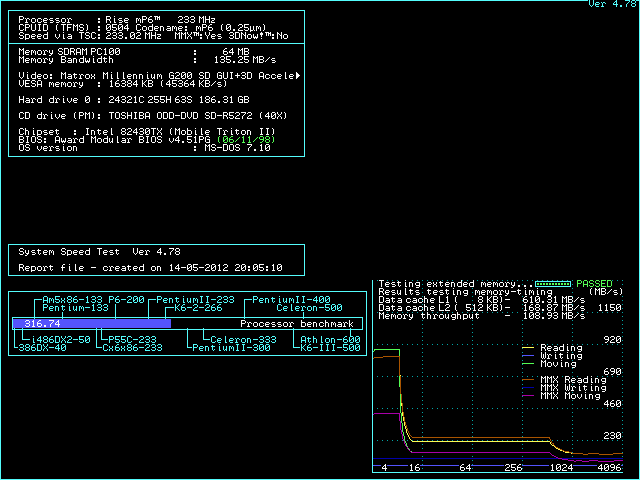feipoa wrote:If we look at these 9 CPUs, could you let me know which fab process you think were employed (.18, .25, .35), […]
Show full quote
If we look at these 9 CPUs, could you let me know which fab process you think were employed (.18, .25, .35),
MII-433GP, 2.2V, 100x3 (300 MHz)
MIIv-433GP, 2.2V, 100x3 (300 MHz)
MII-400GP, 2.2V, 95x3 (285 MHz)
MIIv-400GP, 2.2V, 95x3 (285 MHz)
MII-366GP, 2.9V, 100x2.5 (250 MHz)
MIIv-366GP, 2.2V, 100x2.5 (250 MHz)
MII-333GP, 2.9V, 83x3 (250 MHz)
MIIv-333GP, 2.2V, 66x4 (266 MHz, silver-top)
IBM 6x86MX-PR333, 2.9V, 83x3 (250 MHz)
Apparently, those with a "v" after the MII were the mobile editions. I'm not sure what makes them stand out from the non-v desktop variants though. I have all but the top two.
Without an actual identification code to look at, I could only guess there.
I can take a crack at some pics of Cyrix chips available online though, like these:
http://www.ukcpu.net/Collection/Processors/Cyrix/MII/MII.asp
and here
http://www.chipdb.org/cat-mii-171.htm
All the 400 and 433 parts (with codes visible) seem to be 180 nm parts from mid/late 1999.
Information on black-top chips is a bit vague, and there's nothing on the white/silver top mobiles in that CPU Shack guide.
There also seems to be less info on the IBM branded parts.
All of the NS produced MIIs seem to be 250 nm, and all from '98 or '99.
Oddly, there's a 3x66 PR266 on the ukcpu page that seems to be an IBM 6 layer 250 nm chip, but has a 9 as the date code, implying 1999, but IBM supposedly wasn't manufacturing MIIs at that point and the guide only goes up to 98 as well. (5=95, 6=96, 7=97, 8=98)
There's a white top PR-300 on chipdb that seems to go by the normal (gold top) NS naming convention and seems to be from 1999, but has an undocumented character (A) for the process. (cpushack lists 1, 2, 7, and B as ?, ?, 250 nm, and 180 nm, but no mention of A at all)
From your monologue, it sounds like that Cyrix 6x86 would have made a decent pre-1996 486-optimised gaming CPU.
Your Doom benchmark figures seem to agree with this too, with the 6x86 PR-200 classic outperforms the P55C-166. Albeit, it also beats the 6x86 @ 150/60 MHz, implying the faster external bus and L2 cache are coming into play.
Depending on the type of game, the advantages would vary, but I'd think the ALU and I/O performance in general would favor the Cyrix parts for 2D drawing tasks at least.
For 3D games using 3D points and polygons (unlike doom) it would be even more interesting to compare for games optimized to work without an FPU (for 386/486SX/DLC/etc) as some 3D engines may rely on 16-bit math for faster vertex calculation. I don't have any raw figures on 16-bit integer math performance on these CPUs, but I'd guess its faster than 32-bit, which is generally rather sluggish . . . and still rather slow even in some much later CPUs (falling behind FPU performance considerably).
Again, I wish that passmark test included breakdowns for 8 and 16-bit integer performance, not just "integer" and "floating point." (which may only address 32-bit integer or may average/weigh mixed scores, not sure)
Pretty much any 3D polygonal games prior to quake would fall into this category of integer-only games. Tie Fighter, Wing Commander 4, and Descent would be among the last of those. Tomb Raider may also do this as it apparently works on FPU-less systems, but I'm not 100% on this and haven't tried it myself.
And on the note of integer based 3D engines, MMX should have accelerated integer (fixed point) based 3D math considerably, and I've seen some references to potential use of it, but little info on actual games/drivers that supported it rather than FP. Fixed point math is a bit more restricting due to the lower precision, but its still quite workable for the most part and MMX should have been considerably faster than FPU even with the fast FPUs on Intel chips. (granted, also quite fast MMX units)
